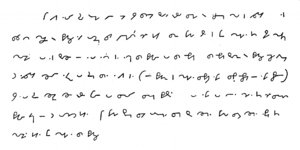Samuel Taylor (stenographer): Difference between revisions
m Persondata |
removed Category:1748 births; added Category:1740s births using HotCat |
||
| (13 intermediate revisions by 11 users not shown) | |||
| Line 1: | Line 1: | ||
{{short description|British stenographer}} |
|||
[[Image:Samuel Taylor shorthand plate XI.png|thumb|300px|Plate XI from Samuel Taylor's shorthand book, 1786]] |
[[Image:Samuel Taylor shorthand plate XI.png|thumb|300px|Plate XI from Samuel Taylor's shorthand book, 1786]] |
||
[[File:Signature of Samuel Taylor (stenographer).jpg|thumb|Taylor's signature, from the end of the subscribers' list of the first edition of the ''Essay''.]] |
|||
'''Samuel Taylor''' (1748/49 – 1811<ref>Butler, 70.</ref>) was the British inventor of a widely used system of [[stenography]]. |
|||
He began working on his own method of stenography in 1773, based on earlier efforts. In 1786, he published ''An |
He began working on his own method of stenography in 1773, based on earlier efforts. In 1786, he published ''An Essay Intended to Establish a Standard for an Universal System of Stenography, or Short Hand Writing...'', the first shorthand system to be used all over the English-speaking world. His stenographic method consisted in cutting out the superfluous consonants as well as the vowels in polysyllabic words. It used an alphabet composed of 19 letters of simplified shapes. |
||
He taught stenography at [[Oxford]] as well as the universities of Scotland and Ireland for many years.<ref>Butler, 70-71</ref> |
He taught stenography at [[Oxford]] as well as the universities of Scotland and Ireland for many years.<ref>Butler, 70-71</ref> |
||
| Line 20: | Line 22: | ||
* Melin, Olof Werling. ''Stenografiens historia''. 1. osa. Tukholma: Nordiska Bokhandeln, 1927. |
* Melin, Olof Werling. ''Stenografiens historia''. 1. osa. Tukholma: Nordiska Bokhandeln, 1927. |
||
:''This article is based on a translation of the corresponding article from the [[French Wikipedia]] and the [[Finnish Wikipedia]]. |
:''This article is based on a translation of the corresponding article from the [[French Wikipedia]] and the [[Finnish Wikipedia]].'' |
||
{{Authority control |
{{Authority control}} |
||
{{Persondata <!-- Metadata: see [[Wikipedia:Persondata]]. --> |
|||
| NAME = Samuel Taylor |
|||
| ALTERNATIVE NAMES = |
|||
| SHORT DESCRIPTION = British stenographer |
|||
| DATE OF BIRTH = 1748 |
|||
| PLACE OF BIRTH = |
|||
| DATE OF DEATH = 1811 |
|||
| PLACE OF DEATH = |
|||
}} |
|||
| ⚫ | |||
| ⚫ | |||
[[Category:1811 deaths]] |
|||
| ⚫ | |||
| ⚫ | |||
[[fr:Samuel Taylor]] |
|||
[[ |
[[Category:1740s births]] |
||
| ⚫ | |||
| ⚫ | |||
Latest revision as of 20:46, 15 July 2024


Samuel Taylor (1748/49 – 1811[1]) was the British inventor of a widely used system of stenography.
He began working on his own method of stenography in 1773, based on earlier efforts. In 1786, he published An Essay Intended to Establish a Standard for an Universal System of Stenography, or Short Hand Writing..., the first shorthand system to be used all over the English-speaking world. His stenographic method consisted in cutting out the superfluous consonants as well as the vowels in polysyllabic words. It used an alphabet composed of 19 letters of simplified shapes.
He taught stenography at Oxford as well as the universities of Scotland and Ireland for many years.[2]
His system was adopted for several other languages, including French, German, Spanish, Italian, and Swedish.[3] His book was translated and published in France by Théodore-Pierre Bertin in 1792 under the title Système universel et complet de Stenographie ou Manière abrégée d'écrire applicable à tous les idiomes.
He also published a book on angling in 1800, titled Angling in All Its Branches.
See also
[edit]Notes
[edit]References
[edit]- Butler, E. H. The Story of British Shorthand. Lontoo: Sir Isaac Pitman & Sons, Ltd., 1951.
- Melin, Olof Werling. Stenografiens historia. 1. osa. Tukholma: Nordiska Bokhandeln, 1927.
- This article is based on a translation of the corresponding article from the French Wikipedia and the Finnish Wikipedia.
